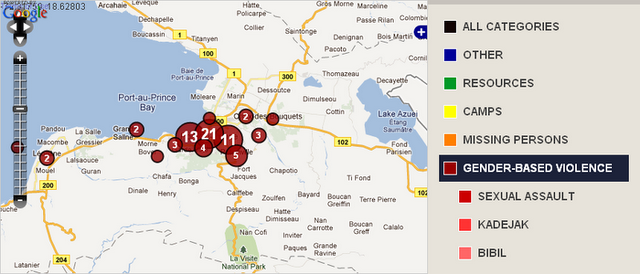-
Addressing Gender-Based Violence Across Humanitarian Development in Haiti
December 5, 2011 By Theresa PolkWomen and girls living in displacement camps in post-earthquake Haiti are “the most vulnerable of a very vulnerable population,” according to Amanda Klasing, women’s rights researcher at Human Rights Watch. Klasing was joined by Leora Ward, technical advisor for women’s protection and empowerment at International Rescue Committee (IRC), and Emily Jacobi, executive director of Digital Democracy, for a November 15 panel discussion at the Wilson Center on gender-based violence in Haiti. “Unless we address the violence – the actual experience of violence that women and girls continue to experience at very high rates in Haiti – we [aren’t] going to be able to create a general environment for women and girls to participate in the rebuilding of their country,” Ward said.
Women More Vulnerable After Natural Disasters
“There is a history and a context for sexual violence in Haiti,” Klasing said. “The earthquake didn’t happen in a bubble.” A study published in The Lancet found that approximately 35,000 women in the Port-au-Prince metropolitan area were victims of sexual assault in the 22 months following the 2004 departure of President Aristide. According to Klasing, sexual violence was historically widely used as a tool for political repression in Haiti, including by security forces during the 1991-94 military regime and under dictator “Baby Doc” Jean-Claude Duvalier.
During and in the aftermath of natural disasters, IRC has found that women are more likely to die than men; are at increased risk of violence; are more vulnerable to lapses in access to health care; and will experience ongoing economic vulnerability, said Ward. “Disasters break down social networks and systems that help protect women and girls,” she said.
While the data on the rate of gender-based violence after Haiti’s earthquake is lacking, “individual vulnerability for gender-based violence has increased, and so the concern, and the response, should reflect that,” Klasing said.
Unfortunately, humanitarian workers rarely undertake measures to respond to sexual violence at the beginning, according to Ward. “Crucial protection systems and response services are typically implemented long after the initial days of the crisis,” she said. “The humanitarian community typically prioritizes food aid, healthcare, water and sanitation services, and shelter from the onset of a response to a natural disaster, often preferring to wait until later to address the issue of sexual violence in an emergency.”
Using Technology To Amplify Women’s Voices
Digital Democracy was formed in 2008 to use technology to enhance civic participation and democratic engagement. The staff already in Port-au-Prince when the earthquake struck became very involved in the technology community’s immediate response, said Jacobi. “Our focus…led us to start working with women specifically, because we felt like they were being just further marginalized and made vulnerable by the disaster relief process,” she said.
Sixty-seven percent of the women in the displacement camps have mobile phones, said Jacobi. Even without access to electricity and other basic needs, women were finding ways to charge their phones and to use those tools to communicate after the disaster, she said.
Digital Democracy helped Haitian NGO KOFAVIV (the Commission of Women Victims for Victims) to incorporate technology into their efforts to provide services and support to victims of sexual violence. They used free, open-source software, such as Frontline SMS and Ushahidi, to facilitate communication and track incidents of gender-based violence. In August, they launched a call center where women can report rapes, access information, and find services.
“The idea of a helpline isn’t very innovative,” Jacobi said, but in Haiti, services like 911 or crisis helplines did not exist. “It is innovative for this group of women to choose to put their resources, and their time, and their energy to trying to reach beyond their current network…to try and reach actually a much wider network in a way technology can do better, than simply sending out women to every single camp.”
Long-Term Funding, Focus on Women Needed
However, despite renewed attention to Haiti, the sustained success of these programs is in question. “Long-term funding for prevention and service provision is a problem–a huge problem–and we are talking about an issue that cannot be resolved in one year, in two years,” said Ward. “Again, [sexual violence] existed before the earthquake, and it has even gotten worse. And funding, I think, cannot be ignored as a critical piece.”
“The perspective of women has not necessarily been taken into account in post-earthquake Haiti, either in the recovery, or in the reconstruction,” added Klasing. “I think that is a challenge for the international community – how are we going to get these women and girls into the process?”
Nevertheless, although the rate of gender-based violence isn’t necessarily decreasing yet, “we are seeing a real building up of resistance networks, and networks of men and women working to combat these challenges,” said Jacobi.
Event Resources:
- Emily Jacobi’s Presentation
- Amanda Klasing’s Presentation
- Leora Ward’s Presentation
- Photo Gallery
- Video
Image Credit: Survivors Connect.
 A Publication of the Stimson Center.
A Publication of the Stimson Center.




